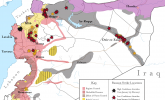2/3/2016 UPDATE: Pro-regime forces backed by heavy Russian air support reestablished a supply line to the partially besieged Shi’a-majority towns of Nubl and Zahra’a northwest of Aleppo City. Opposition forces have denied access to the towns since seizing control of the northern Aleppo countryside in 2012. The regime’s advance severs the opposition-held ground line of communication (GLOC) from the Turkish border into Aleppo City, and positions pro-regime forces to complete the siege of opposition-held neighborhoods of Aleppo City.
Note: The map below surveys Russian airstrikes from January 26-February 1. The developments from today described above will be reflected in a new airstrikes map planned for Friday, February 5.
Key Takeaway: Russian warplanes concentrated their airstrikes in opposition-held territory in northwestern Aleppo Province in support of an ongoing regime offensive to sever the primary opposition ground line of communication (GLOC) from Aleppo City to the Syrian-Turkish border. Pro-regime forces seized three villages in the northern countryside of Aleppo City on February 1 - 2, bringing the regime within five miles of linking with besieged regime forces in the towns of Nubol and Zahraa. The offensive marks the culmination of a series of Russian-backed shaping operations in Aleppo Province that began in October 2015. Anonymous U.S. defense officials confirmed that Russian Spetsnaz special operations forces have also been working to enable the ongoing campaign in Aleppo Province. The isolation of Aleppo City would provide Syrian President Bashar al-Assad and his foreign backers with valuable leverage against their opponents amidst ongoing UN-sponsored Geneva Talks to end the Syrian Civil War. The opposition High Negotiations Committee (HNC) condemned the advances north of Aleppo City on February 2 and reaffirmed that the opposition will not participate in the negotiations until the regime and its allies implement confidence-building measures detailed in previous UN Security Council resolutions, including an end to aerial bombardment on civilian targets. Russia nonetheless attempted to portray itself as a constructive actor in the political process. Russian Foreign Minister Sergey Lavrov announced that Russia has agreed to include representatives from prominent Salafi-jihadist groups Jaysh al-Islam and Ahrar al-Sham in negotiations on an individual basis despite previously condemning the groups as terrorist organizations.
Meanwhile, a
Russian Su-34 bomber violated Turkish airspace on January 29 in the first reported airspace incursion since Turkey downed a Russian fighter jet in November 2015. The Russian Ministry of Defense denied responsibility for the violation, terming the report “
unsubstantiated propaganda” despite NATO confirmation. Russia later claimed to deploy advanced Su-35S air superiority fighters to its airbase at the Bassel al-Assad International Airport in Latakia Province. The deployment of Russia’s most advanced fighter jets to Syria provides a new boost to its ability to provoke Turkey and assert its freedom of action along the southern flank of NATO.
The following graphic depicts ISW’s assessment of Russian airstrike locations based on reports from local Syrian activist networks, Syrian state-run media, and statements by Russian and Western officials. This map represents locations targeted by Russia’s air campaign, rather than the number of individual strikes or sorties.
High-Confidence reporting. ISW places high confidence in reports corroborated both by official government statements reported through credible channels and documentation from rebel factions or activist networks on the ground in Syria deemed to be credible.
Low-Confidence reporting. ISW places low confidence in secondary sources that have not been confirmed or sources deemed likely to contain disinformation.


